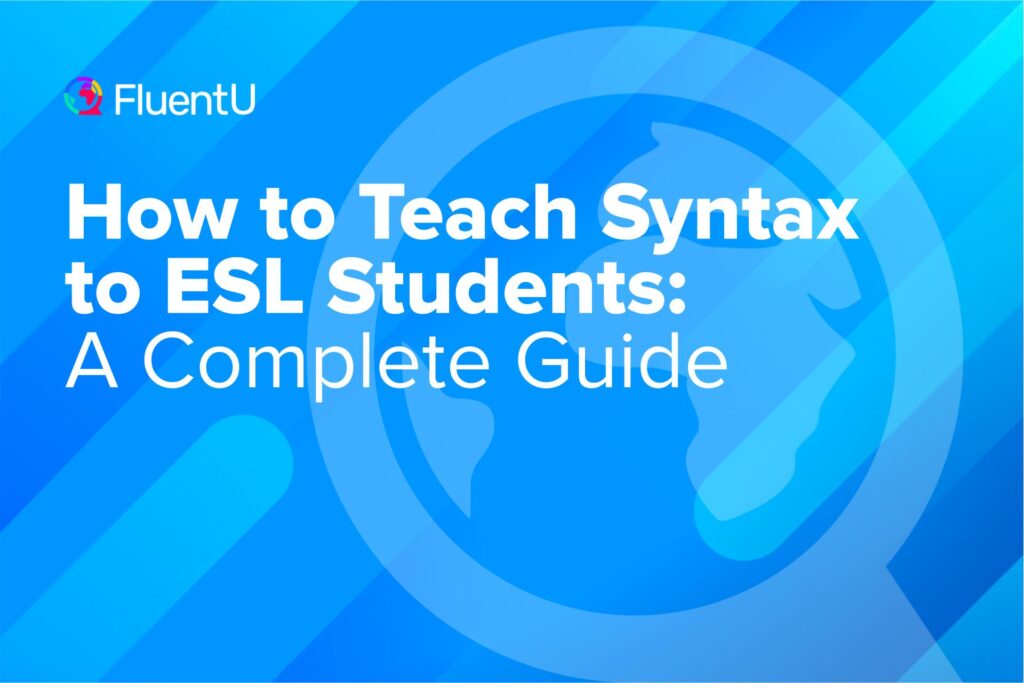Contents
- Why Should ESL Students Learn Syntax?
- How to Incorporate Syntax in an ESL Lesson
- 1. Start by reviewing the vocabulary and phrases from the curriculum
- 2. Write sentences on the board with words out of order
- 3. Ask the students to put the words back in order
- 4. Turn the syntax activity into an ESL game
- 5. Have your students write the correct sentences in their notebooks, then ask volunteers to do the same on the board
- 6. Make an ESL sentence scramble activity for small groups
- And One More Thing...
How to Teach Syntax to ESL Students: A Complete Guide

Many ESL learners—children and adults alike—have no idea what syntax is or how to define it.
Syntax refers to sentence structure; that is, the order of the words in a sentence that makes it understandable to native English speakers.
There are multiple ways to write a sentence while maintaining the rules of grammar, but many ESL students require a set structure for the simple sentences they learn. At least in the beginning, they don’t need to learn how to express the same ideas in active and passive voice.
Let’s review the importance of syntax and how to teach syntax to ESL students.
Download: This blog post is available as a convenient and portable PDF that you can take anywhere. Click here to get a copy. (Download)
Why Should ESL Students Learn Syntax?
It’s important that ESL students recognize word order and sentence structure as soon as possible. As students progress in their English studies, it becomes more difficult to correct syntax problems. In many cases, students translate their native language directly into English without considering the word order that changes between languages. For example, native Spanish speakers tend to place the noun before the adjective, instead of the other way around. When the right structure is reinforced early on, ESL students will develop a natural inclination to use correct syntax.
Native English speakers learn syntax through repetition before they learn the parts of speech and rules of grammar. ESL students generally have little or no understanding of nouns, verbs, adjectives, etc. in their native languages, so there isn’t a reason to teach them that the adjective must precede the noun. The students will, however, notice that colors come before objects in a sentence through recognition of repeated sentence structures. As this concept is reinforced through classroom exercises, the students will utilize the structure when creating their own sentences as they continue learning the language.
Just because a student knows a word doesn’t mean they know how to use it in a sentence. Many students begin learning English by memorizing words and phrases. It’s your responsibility as the teacher to ensure they understand the meaning and usage of these words. Be sure to include more vocabulary than what’s available in a child’s textbook, and instruct students how to alter sentences to fit different situations.
How to Incorporate Syntax in an ESL Lesson
1. Start by reviewing the vocabulary and phrases from the curriculum
In many ESL textbooks, the lessons will have similar phrases and sentences with substituted vocabulary. The ability to replace one or two words in a sentence helps reinforce the structure of the sentence through basic memorization. Many students will focus on the word or two in each sentence that changes, and see the remaining words as a less important, larger group.
For example, if the sentence in the textbook is “I have a red notebook,” the students should already know how to switch the colors and objects in the sentence—e.g., “I have a blue notebook” and “I have a red pencil,” respectively. Depending on age, the students may also be able to change the subject of the sentence. If the students have difficulty replacing such words in a sentence, you should review this process to ensure better comprehension of key vocabulary.
2. Write sentences on the board with words out of order
But what happens when the sentences are altered by more than just one or two words?
Unscrambling English sentences in lessons forces students to think about each word in a sentence rather than only memorizing an entire phrase without understanding the importance of structure. After repeating each word in a sentence individually, students should recognize where each belongs.
It’s a common practice for ESL teachers of all ages and levels to deliberately make mistakes to see if students will notice. Of course, some ESL teachers will unintentionally make mistakes and then play it off as an exercise when the mistakes are pointed out by eagle-eyed students. This exercise helps you gauge whether your students are paying attention and learning the material.
3. Ask the students to put the words back in order
Of course, you’re not going to leave the sentences on the board unscrambled as they are. Ask some of your students to volunteer to rearrange the words such that they conform to proper syntax.
This method can be made easier by using laminated flashcards for each word stuck to the board. Not only does this save on chalk or whiteboard markers, but the flashcards can be also reused for multiple classes.
After the volunteers complete the exercise, ask the class if the sentence is now correct. If the sentence is still not correct, ask another student go up to the board and write it again. Be sure to point out and explain the differences between the correct and incorrect sentences.
4. Turn the syntax activity into an ESL game
For this game, the students can be split into at least two teams. (I have had large enough classes to have four teams of five students.) The game should take 15 to 20 minutes in classes of about 20 students.
- Choose a student from each team. Make sure to pick students that are at a similar level to make the game more fair.
- Show the students the incorrect sentence to rewrite.
- The first student to correctly write the sentence earns a point for their team.
- Go through this process until each student has had an opportunity to participate.
- If none of the students rewriting the sentence gets it correct, ask one more student from each team to help out, but tell the original participants to write the correct sentence.
For students at a lower level in the class, choose easier sentences to improve their confidence. For more advanced students, choose more difficult sentences to challenge them.
5. Have your students write the correct sentences in their notebooks, then ask volunteers to do the same on the board
If your goal is to better gauge the class’s overall comprehension of the material, you may want to give everyone in class the same opportunity to correct the same sentences. This activity should take about 10 minutes to complete.
- Write a few sentences with their words out of order on the board.
- Have the students rewrite the sentences correctly in their notebooks.
- While the students are rewriting the sentences, you can walk around the room and see how each student does with the activity, while providing some one-on-one instruction before moving on to the next student.
- After all the students complete the exercise, invite volunteers (or appoint students) to rewrite the sentences on the board.
- Review each sentence with the class to ensure that everyone understands the corrections.
6. Make an ESL sentence scramble activity for small groups
You can turn the scrambled sentences into a group activity, with groups of no more than five students. (Three or four in a group usually works best, however.) You’ll need laminated word cards that are smaller than what you’d use for class lessons. This activity should take about 15 minutes.
- Place the card sets in reusable bags.
- Split the class into groups of three or four students.
- Hand out a bag of cut-up sentences to each group.
- Have the students rearrange all the words into correct sentences.
- Ask the groups to raise their hands when they’ve completed the activity.
- Check the students’ progress during the activity. Make sure to provide hints for groups that are struggling.
This activity works best with a greater variety of sentences rather than with substitution exercises. It also works when reviewing multiple units at one time. Ensure one student in each group will take the lead and keep the rest of the group on task.
As with the previous methods, invite students to write the corrected sentences on the board and review each with the entire class. You can also go around the room and ask students to read the sentences aloud.
These activities can be used as warm-up exercises to review previous lessons or as end-of-class reviews. They can also be used as transitional exercises depending on the length of the class.
Together, these tips on how to teach syntax to ESL students will add variety to your classes while reinforcing proper sentence structure.
It also helps to show them real-world examples of English syntax so they can learn directly from native speakers. English media clips can be found on the FluentU program, and with its learning features, it could definitely be an asset in the classroom.
FluentU takes authentic videos—like music videos, movie trailers, news and inspiring talks—and turns them into personalized language learning lessons.
You can try FluentU for free for 2 weeks. Check out the website or download the iOS app or Android app.
P.S. Click here to take advantage of our current sale! (Expires at the end of this month.)

Download: This blog post is available as a convenient and portable PDF that you can take anywhere. Click here to get a copy. (Download)
And One More Thing...
If you like learning English through movies and online media, you should also check out FluentU. FluentU lets you learn English from popular talk shows, catchy music videos and funny commercials, as you can see here:
The FluentU app and website makes it really easy to watch English videos. There are captions that are interactive. That means you can tap on any word to see an image, definition, and useful examples.
For example, when you tap on the word "searching," you see this:
Learn all the vocabulary in any video with quizzes. Swipe left or right to see more examples for the word you’re learning.

FluentU helps you learn fast with useful questions and multiple examples. Learn more.
The best part? FluentU remembers the vocabulary that you’re learning. It gives you extra practice with difficult words—and reminds you when it’s time to review what you’ve learned. You have a truly personalized experience.
Start using the FluentU website on your computer or tablet or, better yet, download the FluentU app from the iTunes or Google Play store. Click here to take advantage of our current sale! (Expires at the end of this month.)










